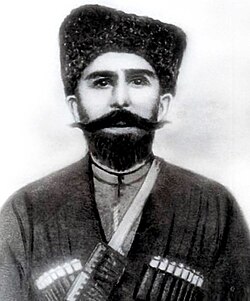Abrek
| Look up Abrek in Wiktionary, the free dictionary. |
The word abrek is a North Caucasian term. In Chechen or Ingush the word abrek has the meaning of "avenger"; in Circassian or Karachay the word has the meaning of "brave man". In the Caucasus the word has the derogatory meaning of "bandit" only in Ossetian and Russian - but these languages belong to the Indo-European language family, and these people have been enemies of Abrek lifestyle in the past.
The term abrek was mostly used for people who struggled against Russian colonialism, mostly a guerrilla fighter during Russian expansion in the Caucasus in the 19th century. The term was also used in the Caucasus for a person who vowed to avoid any pleasures and to be fearless in fighting for the sake of Allah and justice. An abrek renounced any contact with friends and relatives. The abrek lifestyle also included a lonely life in the unexplored wilderness and prayers. Later, the majority of abreks were devoted Muslims.
The word abrek was used[by whom?] as a propaganda term for the anti-Soviet guerrillas of the post-war North Caucasus, as well as for all illegals. Those abreks were widely popularized[by whom?] as the defenders of the motherland and as paupers. In their old age, the abreks of the West Caucasus usually devoted themselves to beekeeping. The majority of the East Caucasus abreks were killed[by whom?] in non-stop warfare against the federal army.
After the establishment of Soviet power in the Caucasus in the 1920s, abreks continued the fight against oppressors, for the most part in Chechnya. The Chechen abreks provoked the rebellions of 1920-21, 1929–31, 1931-1939, and the last in 1940-44, that led to the deportation of the Chechens and Ingush in 1944. The last anti-Soviet Chechen abrek was killed on 28 March 1976 at the age of 70.[1]
History[]
The Russians were habitually raided by the Chechens and the Ingush. Primary Chechen targets were Cossacks who occupied their lowlands. Primary Ingush targets, because of the proximity of the Georgian Military Road, a major artery connecting Russia and Georgia, were Russian trade, banking, and mail services. Both hatred of Slavs (Chechens generally failed to see the distinction between Russians and Cossacks, and to this day they may be used as synonyms) and the need to either fill the mouths of hungry children or to regain lost lands played a vital role. The Chechen raiders, known as abreks, were the focal point of this conflict and are almost symbolic of the two different viewpoints.[citation needed] The Russian view on the abreks is that they were simply mountain bandits, a typical example of Chechen barbarism; however, they were depicted as men of honor by some Russian authors. The Chechen view is that they were heroes of valor, much like Robin Hood. As Moshe Gammer points out in his book Lone Wolf and Bear, Soviet ideology fell somewhere in between the two views- and notably, one such abrek, Zelimkhan, was made a Chechen hero.[2]
See also[]
- Zelimkhan Gushmazukayev - the most prominent Chechen abrek
- - Chechen abrek known for his noble character
- - Chechen abrek, killed by KGB
- - Ingush abrek who killed Russian viceroy to Ingushetia colonel Mitnik. Executed by Russian communists on the orders of Chernoglaz.
- - Ingush abrek who killed Soviet Communist leader of Ingushetia Chernoglaz. Executed by Russian communists.
- - Ingush abrek and a close friend of Zelimkhan Gushmazukayev
- - Ingush abrek, killed by NKVD
- Laisat Baisarova - Ingush woman-sniper who is alleged to have murdered scores of Russian soldiers and NKVD officers 1944-1991. Never killed or captured.
References[]
- ^ (in Russian) (Link flagged by anti-virus protection, 8/19/2021) Khasukha Magomadov bio Archived September 28, 2007, at the Wayback Machine
- ^ Gammer, Moshe. Lone Wolf and Bear. Page 117.
- Rebecca Ruth Gould: The Abrek in Chechen Folklore
- History of the North Caucasus
- Resistance to the Russian Empire
